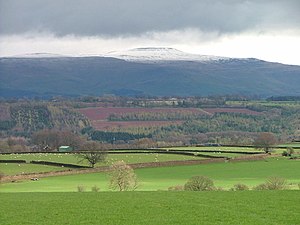Cross Fell
| Cross Fell | |||
| Cumberland | |||
|---|---|---|---|
 Cross Fell, from the Eden Valley | |||
| Range: | Pennines | ||
| Summit: | 2,930 feet NY687343 54°42’10"N, 2°29’14"W | ||
Cross Fell is the highest point in the Pennine Hills and indeed the highest point in England outside of the Lake District. It rises up in Cumberland close to the border of Yorkshire, on the watershed between east and west; from its slopes the River Tees flows eastwards, nearby where the South Tyne rises too, while the westward flow many of the streams which feed the River Eden, including the Crowdundle Beck which marks the border between Cumberland and Westmorland.
The summit, at 2,930 feet is a stony plateau, part of an eight-mile-long ridge running north-west to south-east, which also incorporates Little Dun Fell at 2,762 feet and Great Dun Fell at 2,785 feet. The three adjoining fells form an escarpment that rises steeply above the Eden Valley on its south-western side and drops off more gently on its north-eastern side towards the South Tyne and Tees Valleys.
Cross Fell summit is crowned by a cross-shaped dry-stone shelter. On a clear day there are excellent views from the summit across the Eden Valley to the mountains of the Lake District. On the northern side of Cross Fell there are also fine views across the Solway Firth to the Southern Uplands of Dumfriesshire and Galloway.
The fell is prone to dense hill fog and fierce winds. A shrieking noise induced by the Helm Wind is a characteristic of the locality. The Helm Wind can be very strong where it is channelled down gullies in the side of the escarpment. It is experienced particularly in the villages of Milburn and Kirkland.[1] It can be an inhospitable place for much of the year. In ancient times it was known as "Fiends Fell" and believed to be the haunt of evil spirits. It has been speculated that this last feature may be why the fell became known as Cross Fell.
A conspicuous local feature is the golf-ball-shaped radar installation on the summit of Great Dun Fell. This was built in the 1980s and supports civil air traffic control over the North Atlantic. The original site was built on the summit in 1949.
Local geography
Cross Fell and the adjoining fells are mainly a bed of hard, carboniferous limestone. Where this bed surfaces, there are steep rock faces. There are also strata of shale and gritstone that surface on the fell. On the south and west facing slopes of Cross Fell the rock faces have been broken up by frost action to give a scree slope made up of large boulders. The local terrain shows obvious evidence of recent glaciation and is covered by thin soil and acidic peat.
Cross Fell, Great Dun Fell and Little Dun Fell form a block of high terrain which is all over 2,600 feet in altitude. This is the largest block of high ground in England and tends to retain snow-cover longer than neighbouring areas. Snow can be found in gullies on the north side of Cross Fell as late as May in most years. In some years, lying snow has been known to persist until July and fresh snowfall in June is common.
Rain on Cross Fell averages around 110 inches a year. Local flora includes a number of rare alpine plants such as the Starry Saxifrage and a mountain Forget-me-not. Cross Fell is covered by what is known as "siliceous alpine and boreal grassland". It is the southernmost outlier of this vegetation type, which is common to the Highlands and Scandinavia. The heights of the fell are designated a Special Area of Conservation and local farmers are required to keep free-roaming sheep off the tops of the fells in order to avoid damaging the natural flora.[2]
Cross Fell is a conspicuous feature in the landscape. It dominates the skyline on almost the entire 20-mile length of the A66 trunk road between Penrith and Stainmore. It can also be seen from Helvellyn summit in the Lake District and from high ground throughout Dumfriesshire and Northumberland.
References
- ↑ "The Helm Wind Dufton Village Cumbria". www.dufton.org.uk. http://www.dufton.org.uk/the_helm_bar.htm.
- ↑ "SAC selection - 6150 Siliceous alpine and boreal grasslands". www.jncc.gov.uk. Joint Nature Conservation Committee. Moor House – Upper Teesdale. http://www.jncc.gov.uk/ProtectedSites/SACselection/habitat.asp?FeatureIntCode=H6150.
Outside links
| ("Wikimedia Commons" has material about Cross Fell) |
- Panoramas
- Jonathan de Ferranti. "Cross Fell, North Pennines". www.viewfinderpanoramas.org. http://www.viewfinderpanoramas.org/panoramas/ENG/Cross.gif.
